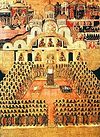

| Previous day | Next day |
| Old Style
March 4
|
Sunday |
New Style
March 17
|
|
First Sunday of Great Lent.
Tone 1.
Great Lent. |
Wine and oil allowed.
|
![]() St. Gerasimus of the Jordan (451). St. Gerasimus of Vologda, founder of the Holy Trinity Monastery (1178). St. Daniel, great prince of Moscow (1303).
St. Gerasimus of the Jordan (451). St. Gerasimus of Vologda, founder of the Holy Trinity Monastery (1178). St. Daniel, great prince of Moscow (1303).
Martyrs Paul and his sister Juliana, and Quadratus, Acacius, and Stratonicus, at Ptolemais in Syria (ca. 273). St. James the Faster, of Phoenicia (Syria) (6th c.). Translation of the relics of Martyr Wenceslaus (Vyacheslav), prince of the Czechs (929-935). Blessed Basil (Vasilko), prince of Rostov (1238). Saints of Pskov martyred by the Latins: St. Ioasaph of Snetogorsk Monastery and St. Basil of Mirozh Monastery (1299). St. Gregory, bishop of Constantia on Cyprus.
New Hieromartyrs Archpriest Dimitry Ivanov of Kiev (1933) and Priest Vyacheslav Leontiev of Nizhegorod (1937).
St. Julian, bishop of Alexandria (189). St. Gregory, bishop of Assos near Ephesus (1150). New Martyr John of al-Sindiyana (Palestine) (1937).
Repose of Schemamonk Mark of Glinsk Hermitage (1893) and Schemanun Agnia (Starodubtseva), eldress, of Karaganda (1976).
Thoughts for Each Day of the Year
According to the Daily Church Readings from the Word of God
By St. Theophan the Recluse

The First Sunday of Lent. [Heb. 11:24–26, 32–12:2; John 1:43–51]
The Sunday of Orthodoxy.[1] Do not forget the right word[2] which you spoke to God, renewing your testament with Him which you broke through your negligence. Remember how and why you broke it and try to avoid being unfaithful again. Pretty words are not glorious; faithfulness is glorious. Is it not glorious to have a testament with a king? How much more glorious is it to have a testament with the King of kings! But this glory becomes your disgrace if you are not faithful to this testament. How many great people have been glorified since the beginning of the world! And all of them have been glorified for their faithfulness, in which they stood firm, regardless of great misfortunes and sorrows as a result of this faithfulness. They had trial of cruel mockings and scourgings, yea, moreover of bonds and imprisonment: They were stoned, they were sawn asunder, were tempted, were slain with the sword: they wandered about in sheepskins and goatskins; being destitute, afflicted, tormented; Of whom the world was not worthy: they wandered in deserts, and in mountains, and in dens and caves of the earth…. Wherefore, seeing we are compassed about with so great a cloud of witnesses, let us run with patience the race that is set before us, looking unto Jesus the author and finisher of our faith (Heb. 11:36–38; 12:1–2).
[1] The first Sunday of Great Lent is called “The Sunday of Orthodoxy,” and celebrates the restoration of the veneration of Icons and the victory of Orthodoxy over the Iconoclast heresy.
[2] “The right word” is a reference to the meaning of the word “Orthodox” in Russian, which is literally “rightly glorifying.”
Articles
 Right-believing Prince Daniel of MoscowHoly Prince Daniel of Moscow was born at Vladimir in the year 1261. He was the fourth son of St Alexander Nevsky. |
 The Holy Martyr Paul and his sister JulianaThe Holy Martyr Paul and his sister Juliana were executed under the emperor Aurelian (270-275) in the Phoenician city of Ptolemais. |
 St. James the Faster of Phoenicia, SyriaSaint James the Faster lived a life of asceticism near the Phoenician city of Porphyrion in the sixth century. |
 Triumph of Orthodoxy SundayFr. Thaddaeus HardenbrookAfter the exercise of Clean Week, the wisdom of the Church grants us a rest in the joy of Triumph of Orthodoxy Sunday. |


















